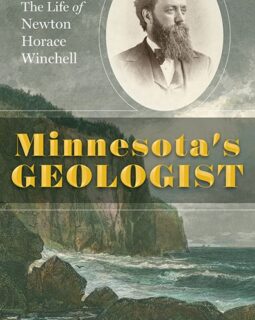Minnesota’s Geologist: The Life of Newton Horace Winchell

- Year
- 2020
- Creators
- Reviewer: Paul Nelson
- Topics
Minnesota’s Geologist: The Life of Newton Horace Winchell
Sue Leaf
Minneapolis, MN: University of Minnesota Press, 2020
280 pages; hardcover, 30 b&w plates, $29.95
Newton Horace Winchell deserves to be remembered. He was probably Minnesota’s greatest nineteenth-century scientist, a giant in not only geology but paleontology and archaeology too. Winchell’s The Geological and Natural History Survey of Minnesota, produced between 1872 and 1899, runs to thousands of pages. His The Aborigines of Minnesota: A Report Based on the Collections of Jacob V. Bower, and on the Field Surveys and Notes of Alfred J. Hill and Theodore H. Lewis is the first attempt at a comprehensive survey of Indigenous peoples in our part of the world. These are foundational works in the understanding of Minnesota’s physical and human history. Winchell was also a compelling personality. Thanks to writer Sue Leaf, we now have a full biography of this remarkable figure.
There is drama in the first half of the book as the young Winchell scrambles to find his place in the world. Born in 1839, he left the family farm in Connecticut—presided over by his dreamy father and can-do mother—at age fifteen to escape its poverty and spent much of the next fifteen years teaching school, mostly in rural Michigan. Along the way, he taught himself Latin, Greek, French, biology, and chemistry. He came to geology at age twenty-nine through an elder brother who taught geology at the University of Michigan. In 1872, Winchell moved to Minneapolis to work for the University of Minnesota and undertake a geological survey of the state. He had found his life’s work—and Minnesota got far more than it bargained for.
Some of the best parts of the first half of the book track Winchell’s adventures in the field (the first love of all geologists) as he roams the state on foot, by boat, and by canoe, gathering rock samples and assembling (first in his mind, later on paper) the patterns of rock wear and glaciation that created the Minnesota we know today. His explorations of the wild country of the Iron Range are particularly entertaining. Along the way, author Leaf doles out the science—elementary geology—in digestible bits. A reader needs no background in geology to follow the story perfectly well.
Once Winchell gets established in his career, the drama drains from the story. Winchell spends most of his time in his office at the university compiling his data, writing his reports, and advancing his career to national significance. It was completely absorbing for him but not for the reader. This is a problem for Sue Leaf; at this point Winchell’s career is not much more interesting than that of a great accountant. She handles this by devoting many pages to the lives of Winchell’s accomplished wife, Lottie—an educator, a feminist, and a national temperance figure—and their gaggle of precocious children. Some people will find the details of family life interesting; others may want to skim. We really don’t need to know what their son Alexander produced in shop class or what the family had for supper that day in London.
Drama picks up again near the end of the book when, in 1899, after twenty-seven years of devoted service, the Regents dismissed Winchell and all of his assistants. Winchell, now nearly sixty and suffering from what we today would call age discrimination, was forced back to scrambling for a dollar—and it did not go well. The scramble ended only in 1906 when the Minnesota Historical Society hired him to investigate the early human history of the state, thus launching a kind of third career for Winchell as archaeologist. This resulted in the monumental, 763-page, profusely illustrated The Aborigines of Minnesota. Archaeology in Minnesota and beyond consumed the rest of Winchell’s professional life. He died in 1914, leaving an imperishable scholarly legacy.
Minnesota’s Geologist is not a geology book but a mostly entertaining biography of a great scientist whose contributions to our state are little remembered. It is a fairly quick and easy read. Those who take it on will get not just Winchell but an introduction to Minnesota geology, portraits of the early University of Minnesota, and a nice sense of family life in late-nineteenth century Minneapolis.
Paul Nelson is an amateur historian living in St. Paul. He is the author of many publications of Minnesota history and a graduate of the University of Minnesota Law School.
- Year
- 2020
- Creators
- Reviewer: Paul Nelson
- Topics